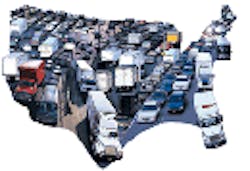Taking money out of people’s pockets is usually met with heavy resistance. But when it comes to the future of our business interests, two panels at Tuesday’s “Infrastructure—A Path to Prosperity” conference, sponsored by Terex and held at Iona College in New Rochelle, NY, stressed the need for long-term thinking to solve U.S. infrastructure woes, because paying for necessary improvements now is better than paying a lot more later.
“We’re focused on the short term, but the projects we work on today will serve the region for 100 years,” said Admiral Richard Larrabee, Director of the Port Commerce Department of the Port Authority of New York & New Jersey.
“Anyone in business building anything depends on infrastructure,” said John Engler, former Governor of Michigan and president of the National Association of Manufacturers. “It’s all about reliability, the adequacy, and the ability to compete…in 30 years, if we don’t make any changes, it’ll be a horror film.”
“How do we think about our infrastructure outside of a tragedy?” said Harold Ford, Jr., vice chairman and senior policy advisor, Merrill Lynch, and former U.S. Rep (D-TN). “How do we alter the short-term outlook in a way that will cause our public policy makers to provoke citizens?”
One of the biggest themes of the conference was thinking of infrastructure as an investment, instead of just money that needs to be spent now. “Somehow as a nation, we view infrastructure as something we can’t afford, as a cost, instead of an investment,” said Stephen Flynn, Jeane J. Kirkpatrick Senior Fellow for National Security Studies, Council on Foreign Relations. “This is an opening for a national conversation.”
“It’s a system and we need to think about it as a system,” said Larrabee. “We couldn’t get anybody’s attention before Exxon Valdez crashed. That gave us the momentum to change things.”
The link between infrastructure and national security was echoed by a number of the panelists. “We don’t want to be a brittle, attractive target to terrorists because they will change the way they conduct warfare,” Flynn said. “It’s a national security imperative… the more we invest in infrastructure, the more we make ourselves a far less attractive target.”
But Bud Griffis, director of the Center for Construction Management Technology, Polytechnic University, said that his fellow panelists were taking an overly negative view of the U.S. infrastructure, and there is lots of good being done, although we need both new funds and new ideas. “We need some vision, and right now there is an extreme lack of vision,” he said.
Dan McNichol, author of The Roads That Built America, said that roads should be our first priority when it comes to infrastructure. “We are a road culture, and our interstate highway system is the envy of the world,” he said. However, he added that the 47,000 miles of highway in the U.S. represents 1% of the roads but 25% of the travel, which is leading to far too much congestion on the interstates.
“We have low expectations for transit,” said Tyler Duval, Assistant Secretary for Transportation Policy, U.S. Dept. of Transportation. He added that we now have 300% higher travel delays since 1982, which has led us to simply expect congestion.
“We should be outraged that this is going on around us,” Flynn said. “Now we don’t trust our leadership to spend our money.”
The panelists were in favor of the need for capital going towards infrastructure projects to come from both public and private sources. “Everyone wants infrastructure, but nobody wants to pay for it,” said Dick Gephardt, former U.S. Representative and Majority Leader (D-MO) and president & CEO of The Gephardt Group. “We have a continuing—and irrelevant—debate about whether these problems should be solved by public or private means. It needs to be both.”
“This debate has to be about putting a creative solution out there,” Engler added. “It’s a two-decade long commitment, and it doesn’t get any easier, so let’s start now.”
